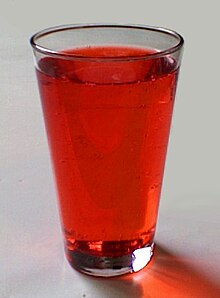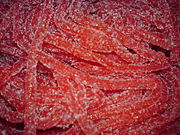Allura red AC
| Structural formula | |||||||||||||||||||
|---|---|---|---|---|---|---|---|---|---|---|---|---|---|---|---|---|---|---|---|

|
|||||||||||||||||||
| General | |||||||||||||||||||
| Surname | Allura red AC | ||||||||||||||||||
| other names | |||||||||||||||||||
| Molecular formula | C 18 H 14 N 2 Na 2 O 8 S 2 | ||||||||||||||||||
| Brief description |
red solid |
||||||||||||||||||
| External identifiers / databases | |||||||||||||||||||
|
|||||||||||||||||||
| properties | |||||||||||||||||||
| Molar mass | 496.42 g mol −1 | ||||||||||||||||||
| Physical state |
firmly |
||||||||||||||||||
| Melting point |
> 300 ° C |
||||||||||||||||||
| solubility |
soluble in water |
||||||||||||||||||
| safety instructions | |||||||||||||||||||
|
|||||||||||||||||||
| Toxicological data | |||||||||||||||||||
| As far as possible and customary, SI units are used. Unless otherwise noted, the data given apply to standard conditions . | |||||||||||||||||||
Allura Red AC is a red azo dye and is approved in the European Union as E 129 food coloring .
properties
It is a dark red, water-soluble solid. The UV / VIS absorption spectrum shows a maximum at a wavelength of 504 nm .
use
Allura Red AC is used in the production of confectionery , desserts , beverages , fizzy drinks , bitter soda and minced meat dishes that contain grain (full English breakfast); as well as medication. So far, no side effects have been proven for the human organism, but as an azo dye , Allura red is suspected to be the trigger of pseudoallergies with symptoms on the skin or respiratory tract in predisposed people, especially those who are intolerant to ASA or benzoic acid . For people who suffer from asthma or neurodermatitis , consumption is classified as questionable. Hyperactivity has been found in animal experiments .
The permissible daily dose (ADI) was set by the National Academy of Sciences (USA) at 7 mg / kg body weight. The EFSA has set the same limit.
Legal situation
Use in food is banned in Denmark , Sweden , Belgium , Switzerland and France . In Austria , its use was also prohibited until joining the EU, but is now permitted. In Sweden it is banned for use in animal feed, but the dye can be found in gummy bears and other sweets. A ban is now being discussed.
As of July 20, 2010, foods containing this color must bear the following note on the label: "May impair activity and attention in children".
Individual evidence
- ↑ Entry on E 129: Allura Red AC in the European database on food additives, accessed on June 16, 2020.
- ↑ From Shampoo to Cereal: Seeing to the Safety of Color Additives . Archived from the original on January 15, 2008. Retrieved June 4, 2008.
- ↑ Food Color Facts . Archived from the original on October 1, 2007. Retrieved August 18, 2006.
- ↑ a b Entry on Allura Red AC. In: Römpp Online . Georg Thieme Verlag, accessed on November 11, 2014.
- ↑ a b c d e data sheet Allura Red AC at Sigma-Aldrich , accessed on May 14, 2017 ( PDF ).
- ↑ a b Zusatzstoffe-online.de .
- ↑ Doris Preißler: Terrible knowledge: 665 facts that you would rather not have known . Riva Verlag, 2011, ISBN 3-86413-122-7 ( limited preview in Google Book Search).
- ^ Joint FAO / WHO Expert Committee on Food Additives (JECFA), Monograph for ALLURA RED AC , accessed on December 9, 2014.
- ↑ EFSA Panel on Food Additives and Nutrient Sources added to Food (ANS): Scientific Opinion on the re-evaluation of Allura Red AC (E 129) as a food additive on request from the European Commission. EFSA Journal 2009; 7 (11): 1327, doi: 10.2903 / j.efsa.2009.1327 .
- ↑ Bernd Leitenberger: What's in it ?: The tricks of the industry in food labeling ... BoD - Books on Demand, 2009, ISBN 3-8370-3561-1 , p. 85 ( limited preview in Google Book search).
- ↑ Dye Ordinance , version of April 3, 2009.
- ↑ SvD .
- ↑ European Food Safety Authority (EFSA): Assessment of the results of the study by McCann et al. (2007) on the effect of some colors and sodium benzoate on children's behavior - Scientific Opinion of the Panel on Food Additives, Flavors, Processing Aids and Food Contact Materials (AFC). ( Memento of June 6, 2010 in the Internet Archive ) In: EFSA Journal. 6, 2008, p. 660, doi : 10.2903 / j.efsa.2008.660 .

